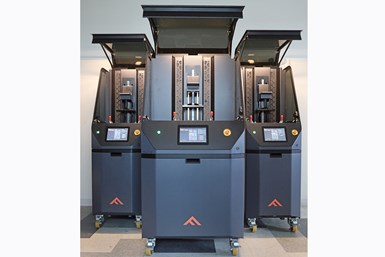Photopolymer Printers, Open Access Software Enable New Applications
The company’s printer versions are tailored for specific-use cases, giving users the power to develop new advanced materials.

Fortify Flux series printers
Fortify, a developer of an advanced filled-photopolymer 3D printing platform, has extended its Flux series product lineup to include new printers and software that enable customers and partners access to develop more end-use part applications.
The company’s printer versions are tailored for specific-use cases, giving users the power to enter new markets. All Fortify 3D printers employ the company’s Continuous Kinetic Mixing (CKM) processing technology, which enables printing of heavily filled photopolymers while maintaining homogeneity. Fortify’s other technology, Fluxprint magnetic alignment, is now available in two configurations.
The Flux Core is Fortify’s baseline 3D printer, which includes CKM and is well suited for processing viscous particle-filled resins where magnetic alignment is not required. Applications include RF devices and electronic applications.
The Flux One was released in 2020 and adds Fluxprint Z (Z-axis magnetic field) to the baseline Core 3D printer. The system overcomes the persistent challenge of Z-axis anisotropy in 3D printing. Applications include robust mold tooling, jigs and fixtures.
The Flux 3D leverages Fluxprint 3D (3-axis magnetic field) to the baseline Core 3D printer, providing users with higher levels of control to align fiber in any axis throughout parts as they are printed. Applications include heat sinks, heat exchangers and high-performance industrial connectors.
Fortify’s Flux Developer is a software platform that can be used on any of the Flux printers. It gives users the ability to push the limits of material properties by opening access to all processing parameters. With this expanded processing window, users can control variables such as exposure time and intensity, material flow, resin temperature and viscosity, and even the build plate mechanics, as they develop and onboard new materials. The company says the Flux Developer is the tool kit users need to test and optimize new materials for targeted applications.
Related Content
-
Copper, New Metal Printing Processes, Upgrades Based on Software and More from Formnext 2023: AM Radio #46
Formnext 2023 showed that additive manufacturing may be maturing, but it is certainly not stagnant. In this episode, we dive into observations around technology enhancements, new processes and materials, robots, sustainability and more trends from the show.
-
Airless Basketball Shows Promise of 3D Printed Lattices: The Cool Parts Show Bonus
Successfully matching the performance of a standard basketball demonstrates the control possible over the mechanical properties of digital materials.
-
Possibilities From Electroplating 3D Printed Plastic Parts
Adding layers of nickel or copper to 3D printed polymer can impart desired properties such as electrical conductivity, EMI shielding, abrasion resistance and improved strength — approaching and even exceeding 3D printed metal, according to RePliForm.














